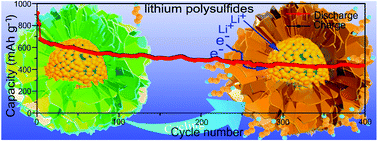Multifunctional NiCo2O4 nanosheet-assembled hollow nanoflowers as a highly efficient sulfur host for lithium–sulfur batteries†
Abstract
Herein, a simple approach was developed to fabricate novel NiCo2O4 hollow nanoflowers (NCOHFs), which were explored as a sulfur carrier material for lithium–sulfur (Li–S) batteries. Remarkably, the capacity of the NCOHF/S composite electrode was ∼666.8 mA h g−1 in the fourth cycle, which was maintained at ∼432.9 mA h g−1 in the 400th cycle under a current density of 1.0C, with a low decay rate of 0.087% per cycle. The overall outstanding properties of the NCOHF/S composite are attributed to the successful new strategy in structural design via in situ and ex situ procedures. Firstly, NCOHF with bifunctional catalytic activity and chemical adsorption can efficiently promote the redox reactions of lithium polysulfides (LiPSs) and suppress the diffusion of polysulfides. Secondly, NCOHF with inherently high electronic conductivity acts as a conduit to accelerate the transport of electrons and ions. Thirdly, the flower-like NiCo2O4 nanosheets are anchored tightly to the conductive carbon and binder during the Li+ insertion and extraction processes, which can effectively suppress the aggregation of the NCOHF/S composite during cycling. Finally, the hollow space inside the NCOHF/S composite provides sufficient free space for the expansion of encapsulated pure sulfur.



 Please wait while we load your content...
Please wait while we load your content...